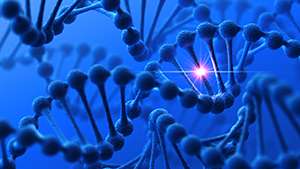Genetic disease linked to protein build-up

Mutations of the gene Lmna previously thought to be directly responsible for a group of laminopathies—serious developmental conditions including premature aging and a form of muscular dystrophy—in fact cause them by allowing a critical protein to accumulate. An international collaborative group of researchers including Ya-Hui Chi and co-workers at the A*STAR Institute of Medical Biology have discovered in mice that reducing levels of the protein, Sun1, resulted in decreased severity of the diseases and longer life spans. This breakthrough finding may eventually lead to changes of the treatment strategy for developmental conditions.
The inner membrane of the cell nucleus is strengthened by a meshwork of protein filaments known collectively as the nuclear lamina. In mammals, the Lmna gene encodes two of the proteins that form the lamina filaments. Mice with two copies of dysfunctional Lmna genes model human Emery-Dreifuss muscular dystrophy (EDMD), and mice with genes incorporating a mutation that deletes 40 amino acids from the Lmna gene show features of the premature aging syndrome Hutchinson-Gilford progeria (HGPS). All these mice have misshapen cellular nuclei, degenerative tissues and organs, and short lives.
Recent research has shown that, as well as keeping the membrane in shape, the nuclear lamina is involved in activating genes, repairing DNA and organizing the nucleus. In order to investigate these roles, the researchers generated EDMD and HGPS model mice with genes encoding dysfunctional Sun1, a protein involved in linking the nuclear lamina and the cytoskeleton within the cell. To their surprise, these mice showed milder developmental defects and lived for longer.
In fact, cells from EDMD and HGPS model mice display an excessive accumulation of Sun1. The researchers found the same to be true of human cells taken from those afflicted by HGPS. Their developmental problems were alleviated by lowering the level of Sun1. Further work suggested that the accumulation of Sun1 was the result not of increased production of the protein, but reduced degradation.
"Collectively the findings implicate Sun1 build-up as the common event of the disorders," says Chi. "We suspect that clinical trials and therapies that target the protein products of dysfunctional genes without resolving the Sun1 accumulation are ineffective or useless against HGPS. In fact, our experimental evidence shows that reduced metabolic turnover of Sun1 is a major cause of HGPS."
Chi and co-workers now want to investigate what factors interact with Sun1 for it to accumulate, and also if there are any other proteins responsible for HGPS.
More information: Chen, C-Y., Chi, Y-H., Mutalif, R. A., Starost, M. F., Myers, T. G., et al. Accumulation of the inner nuclear envelope protein Sun1 is pathogenic in progeric and dystrophic laminopathies. Cell 149, 565–577 (2012). Article















